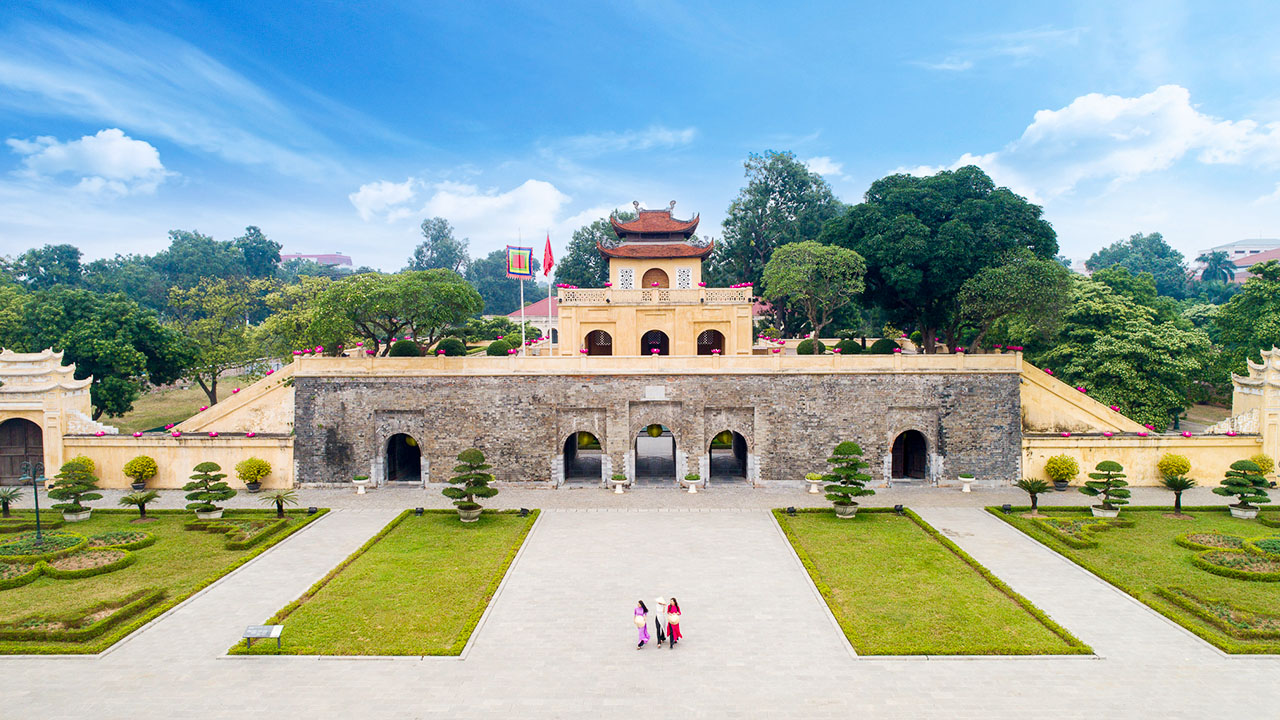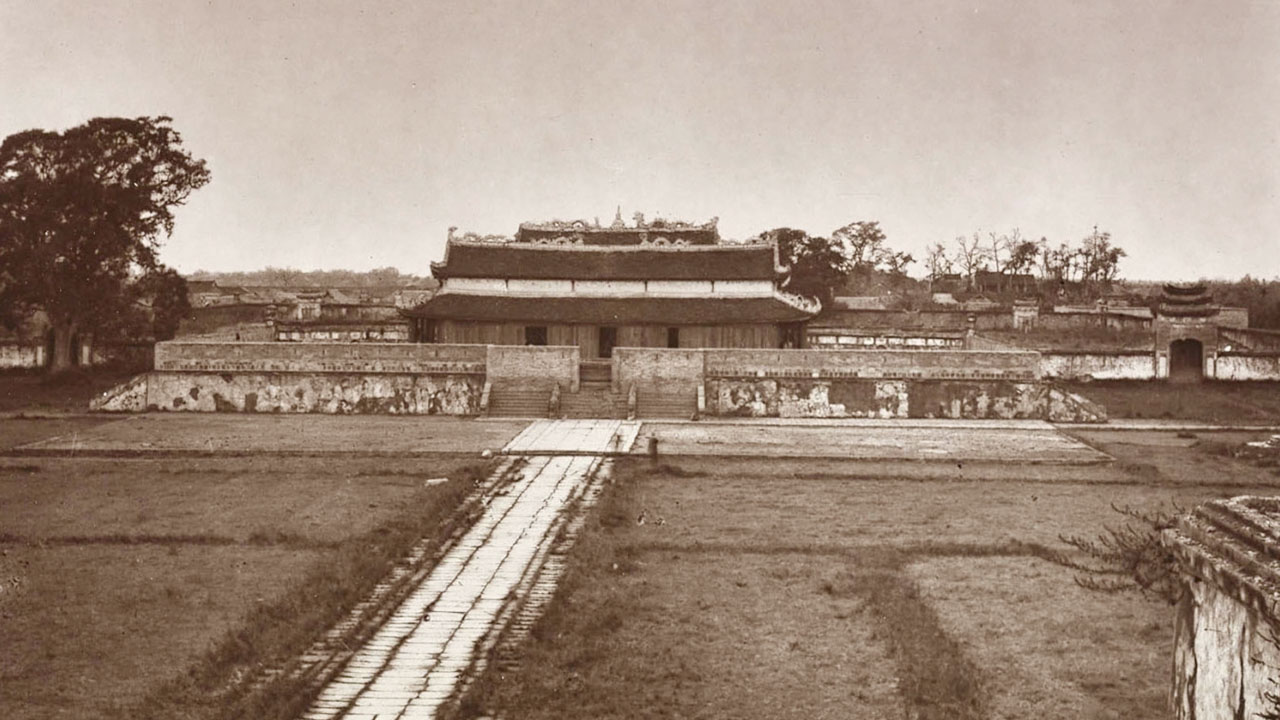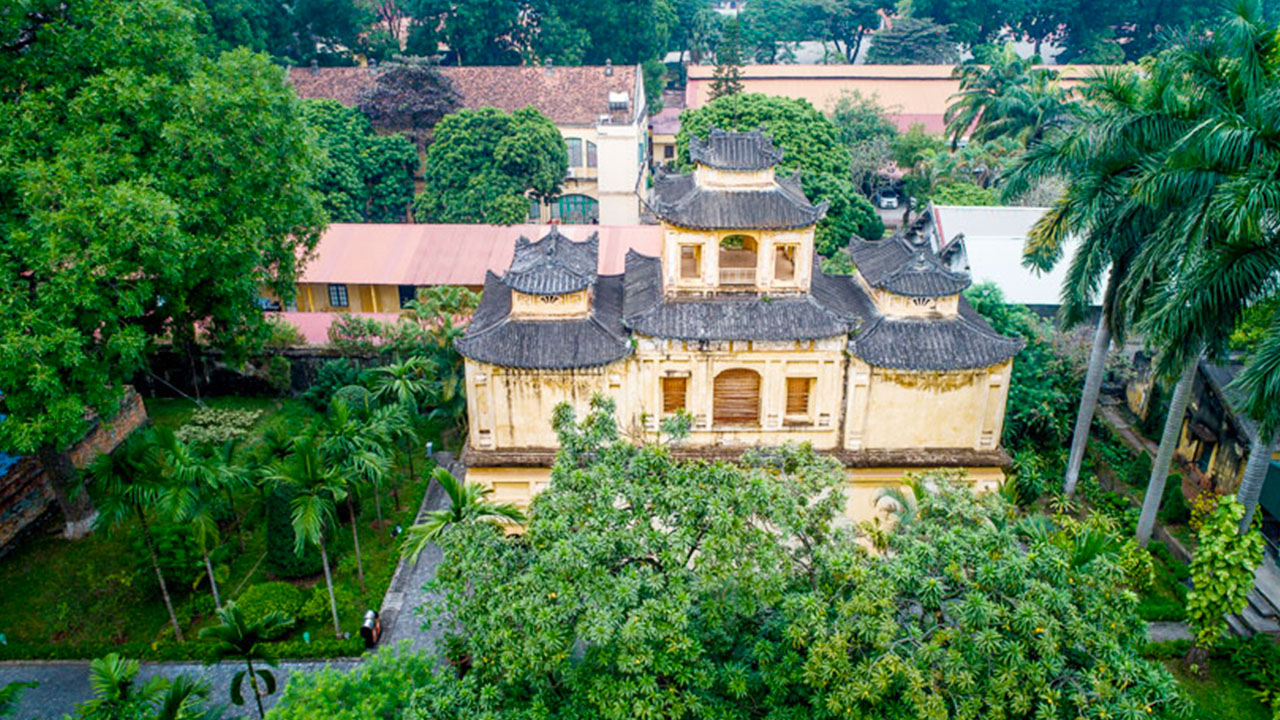The Imperial Citadel of Thang Long, a UNESCO World Heritage site, is a remarkable embodiment of Vietnam’s rich and captivating history. Nestled in the heart of Hanoi, this ancient citadel has served as the political and cultural nucleus of the nation for centuries. It has witnessed the rise and fall of dynasties, shaping Vietnamese identity and culture along the way. The architectural grandeur, archaeological treasures, and cultural significance of the citadel continue to enthrall visitors from around the globe. This article delves into the historical significance, architectural features, archaeological discoveries, visitor information, noteworthy structures, and cultural experiences associated with the Imperial Citadel of Thang Long.

Historical Significance
Origins and Establishment in the 11th Century
The origins of the Imperial Citadel of Thang Long trace back to the early 11th century when Emperor Ly Thai To, the founder of the Ly Dynasty, made a pivotal decision to relocate the capital from Hoa Lu to Thang Long, which translates to “Ascending Dragon.” This strategic move was not merely a change of scenery; it marked the beginning of a new era for Vietnam. The chosen location within the Red River Delta offered geographic advantages that would facilitate trade, agriculture, and defense.

The establishment of the citadel on this historically significant site was no accident. Archaeological evidence suggests that the area had been inhabited for thousands of years prior to the construction of the citadel. The foundations of the citadel were built upon layers of history, including remnants of earlier settlements and structures. This rich tapestry of human activity laid the groundwork for what would become the political and cultural heart of Vietnam.
As the capital, Thang Long flourished under the Ly Dynasty, becoming a hub for commerce, education, and the arts. The citadel itself was designed to reflect the power and authority of the emperor, with walls and gates constructed to protect the royal court from external threats. The citadel’s design incorporated elements of traditional Vietnamese architecture while also drawing inspiration from Chinese influences, showcasing the cultural exchange that characterized this period.
Role as the Political Center of Vietnam
Throughout its history, the Imperial Citadel served as the seat of power for several prominent Vietnamese dynasties, including the Ly, Tran, Le, and Nguyen. Each dynasty contributed to the citadel’s expansion and enhancement, leaving behind architectural marvels and cultural legacies. Within the citadel’s walls, emperors ruled the kingdom, issuing edicts, managing affairs of state, and hosting foreign dignitaries.
The citadel was not only a political center but also a vibrant cultural hub. Scholars, poets, and artists flocked to Thang Long, drawn by the opportunities to engage with the imperial court and contribute to the nation’s intellectual and creative growth. The presence of these luminaries fostered an environment where literature, philosophy, and the arts thrived, leading to a flourishing of Vietnamese culture.
Moreover, the citadel played a crucial role during times of conflict and upheaval. It was here that military strategies were devised, and defenses were organized to protect the nation from invasions. The citadel’s walls bore witness to battles fought for independence and sovereignty, making it a symbol of resilience and strength for the Vietnamese people.
UNESCO World Heritage Site Recognition
In 2010, the Imperial Citadel of Thang Long received official recognition from UNESCO as a World Heritage site, a testament to its global significance. The UNESCO inscription highlighted the citadel’s unique blend of architectural features, archaeological value, and historical importance. This recognition not only elevated the citadel’s status on the international stage but also underscored its role within the larger narrative of Southeast Asian history and culture.

The UNESCO designation brought increased attention to the citadel, attracting tourists, scholars, and researchers eager to explore its rich heritage. Efforts to preserve and promote the site have intensified, ensuring that future generations can appreciate its historical and cultural significance. The recognition also serves as a reminder of the importance of safeguarding cultural heritage in the face of modernization and urban development.
Today, the Imperial Citadel of Thang Long stands as a living museum, inviting visitors to immerse themselves in the stories of Vietnam’s past. Its inclusion on the UNESCO World Heritage list has solidified its position as a must-visit destination for anyone seeking to understand the complexities of Vietnamese history and culture.
Architectural Features
Doan Mon Gate: The Main Entrance
The Doan Mon Gate, known as the Gate of the Morning Light, serves as the main entrance to the Imperial Citadel of Thang Long. This imposing structure is a stunning example of traditional Vietnamese architecture, characterized by its grand design and intricate details. With two towering pillars and a roof adorned with decorative tiles, the gate immediately captures the attention of visitors as they approach the citadel.

The name “Doan Mon” reflects the symbolic importance of the gate as the gateway to the heart of the kingdom. Historically, it was through this entrance that emperors received their subjects and welcomed foreign emissaries. The gate’s design incorporates elements of both functionality and aesthetics, serving as a protective barrier while also conveying the majesty of the imperial court.
As visitors pass through the Doan Mon Gate, they are transported into a world steeped in history. The architectural grandeur of the gate sets the tone for the journey ahead, inviting exploration of the citadel’s many wonders. The surrounding gardens and pathways enhance the experience, providing a serene backdrop against which the citadel’s history unfolds.
Kinh Thien Palace: The Heart of the Citadel
At the core of the Imperial Citadel lies the Kinh Thien Palace, once the grandest architectural structure within the complex. This magnificent palace served as the heart of the royal court, where emperors held court, conducted official ceremonies, and carried out their daily duties. Although only the foundations of the palace remain today, its scale and design speak volumes about the power and grandeur of Vietnam’s imperial past.

The Kinh Thien Palace was not just a functional space; it was a symbol of the emperor’s authority and the cultural richness of the time. Elaborate decorations, intricate carvings, and beautifully crafted furnishings adorned the palace, reflecting the artistic achievements of the era. The layout of the palace was carefully planned, with designated areas for various activities, including audience halls, ceremonial spaces, and private quarters.
Visitors to the citadel can still sense the echoes of history within the remnants of the Kinh Thien Palace. Guided tours often highlight the significance of this structure, offering insights into the daily life of the royal court and the rituals that took place within its walls. The palace’s foundations serve as a poignant reminder of the opulence and complexity of Vietnam’s imperial history.
Hanoi Flag Tower: A Symbol of Independence
Another iconic structure within the Imperial Citadel is the Hanoi Flag Tower, a powerful symbol of Vietnam’s independence and resilience. Originally built during the reign of the Le Dynasty, the tower has undergone repairs and renovations over the centuries, standing tall as a testament to the nation’s enduring spirit.

The Hanoi Flag Tower is distinguished by its impressive height and striking design. Rising above the citadel, the tower features a series of tiers adorned with intricate decorations, culminating in a large flagpole that proudly displays the national flag. The tower’s prominence within the citadel underscores its significance as a symbol of national pride and unity.
Historically, the Hanoi Flag Tower witnessed pivotal moments in Vietnam’s struggle for independence. Notably, it was at this site that the Declaration of Independence was proclaimed in 1945, marking a turning point in the nation’s fight for freedom. Today, the tower stands as a reminder of the sacrifices made by the Vietnamese people in their pursuit of sovereignty, inspiring visitors to reflect on the country’s tumultuous history.
Archaeological Discoveries
Excavations at No. 18 Hoang Dieu
In the 1980s, a groundbreaking archaeological discovery occurred at No. 18 Hoang Dieu Street, located near the Imperial Citadel. Excavations conducted at this site unearthed ancient structures and artifacts, shedding light on the citadel’s history and the lives of those who inhabited it. This discovery added a new layer of understanding to the historical narrative of the citadel and provided valuable insights into Vietnam’s early periods of development.

The excavation revealed remnants of walls, foundations, and other architectural features that date back to different dynasties. These findings suggest that the area surrounding the citadel was a bustling center of activity, with evidence of residential and administrative structures. The artifacts uncovered during the excavations include pottery, tools, and everyday items, offering a glimpse into the daily lives of the people who lived within the citadel’s walls.
The significance of the excavations extends beyond mere artifacts; they provide a tangible connection to Vietnam’s past. The discoveries have prompted further research and exploration, allowing historians and archaeologists to piece together the complex tapestry of life in ancient Vietnam. The insights gained from these excavations continue to enrich our understanding of the cultural and historical context of the Imperial Citadel.
Artifacts from Different Dynasties
The archaeological excavations at various sites within and around the Imperial Citadel have yielded an impressive collection of artifacts that span different dynasties. These artifacts offer a fascinating glimpse into the lives and culture of ancient Vietnamese people, revealing the intricacies of their daily existence and the artistic achievements of the time.
Among the artifacts discovered are pottery fragments, bronze objects, ceramics, and tools, each telling a story of craftsmanship and creativity. The diversity of these artifacts reflects the cultural exchange that occurred throughout Vietnam’s history, influenced by neighboring regions and dynasties. For instance, the presence of Chinese ceramics alongside indigenous pottery highlights the interactions between Vietnam and its neighbors.
Additionally, remnants of royal clothing and furniture have been uncovered, providing insights into the opulence and sophistication of the imperial court. The meticulous craftsmanship evident in these artifacts speaks to the skill and artistry of ancient Vietnamese artisans. Visitors to the citadel can marvel at these treasures, gaining a deeper appreciation for the cultural heritage that has shaped Vietnam over the centuries.
Insights into Ancient Vietnamese Culture
The artifacts and architectural remains discovered within the Imperial Citadel offer invaluable insights into the ancient Vietnamese way of life. The meticulous craftsmanship evident in the construction of the citadel, the intricately decorated artifacts, and the diverse cultural elements preserved within the royal tombs all provide a window into the cultural heritage of Vietnam.

The discovery of ancient inscriptions and historical documents has illuminated the complex political structure and cultural traditions that flourished within the citadel over centuries. These writings reveal the values, beliefs, and practices of the Vietnamese people, shedding light on their relationship with the land, their rulers, and each other.
Moreover, the architectural features of the citadel reflect the harmonious blend of functionality and aesthetics that characterized ancient Vietnamese design. The use of natural materials, intricate carvings, and thoughtful spatial arrangements demonstrate a deep respect for nature and an understanding of the principles of balance and harmony. This cultural ethos continues to resonate in contemporary Vietnamese society, making the citadel a vital link between the past and present.
Visitor Information
Admission Fees and Ticketing Options
Visitors to the Imperial Citadel of Thang Long can easily access the site through various ticketing options. Tickets can be purchased at the main entrance or online through the official website, allowing for a convenient and efficient entry process. The entrance fee is relatively affordable, making it accessible to a wide range of visitors, from local residents to international tourists.
Discounted rates are available for students, seniors, and groups, encouraging greater participation in exploring this historical marvel. The affordability of admission fees reflects the commitment to promoting cultural heritage and ensuring that everyone has the opportunity to experience the rich history of the citadel.
Upon entering the citadel, visitors receive a map and information guide, helping them navigate the expansive grounds and discover the key attractions. The well-maintained pathways and signage make it easy to explore the site at one’s own pace, ensuring a fulfilling experience for all.
Guided Tours and Experiences
To fully appreciate the historical significance of the Imperial Citadel, visitors can opt for guided tours conducted by knowledgeable local guides. These tours provide valuable insights into the citadel’s history, architectural features, and archaeological discoveries, enhancing the overall experience. Guides share captivating stories and anecdotes that bring the past to life, allowing visitors to connect with the rich heritage of the site.
In addition to general tours, there are themed experiences available that focus on specific aspects of the citadel’s history. For example, some tours delve into the royal life of emperors and empresses, while others explore the military significance of the citadel during times of conflict. These specialized tours cater to diverse interests, ensuring that every visitor finds something that resonates with them.
For those seeking a more immersive experience, interactive workshops and cultural demonstrations are often offered within the citadel. Visitors can participate in traditional crafts, music performances, and cooking classes, providing a hands-on opportunity to engage with Vietnamese culture. These experiences create lasting memories and deepen the understanding of the citadel’s cultural significance.
Best Times to Visit the Citadel
The Imperial Citadel can be visited throughout the year, though the ideal time to explore the site is during the spring and autumn months when the weather is pleasant and sunny. During these seasons, temperatures are moderate, and the gardens within the citadel bloom with vibrant colors, creating a picturesque setting for exploration.
Visitors are advised to avoid the hottest months of summer, particularly from June to August, when humidity levels can be excessively high. Exploring the citadel during this time may be uncomfortable, detracting from the overall experience. Instead, planning a visit during the cooler months allows for a more enjoyable and leisurely exploration of the site’s many attractions.
Additionally, special events and festivals often take place within the citadel throughout the year, providing unique opportunities for visitors to engage with Vietnamese culture. Checking the event calendar before planning a visit can enhance the experience, allowing guests to partake in traditional performances, exhibitions, and celebrations that showcase the vibrancy of Vietnamese heritage.
Noteworthy Structures
Revolutionary House D67: A Historical Landmark
Located within the citadel grounds, Revolutionary House D67 stands as a historical landmark that played a significant role in Vietnam’s struggle for independence. This modest building served as the headquarters of the Việt Minh during the First Indochina War (1946-1954), where Ho Chi Minh and other leaders planned and orchestrated resistance against French colonial forces.
The significance of Revolutionary House D67 extends beyond its physical structure; it embodies the spirit of determination and resilience that characterized the Vietnamese people’s fight for freedom. The building’s simple yet functional design reflects the practicality of the revolutionary leaders who operated within its walls, prioritizing strategy and collaboration over luxury.
Today, Revolutionary House D67 serves as a museum, showcasing artifacts, photographs, and documents related to the Việt Minh’s efforts during the war. Visitors can gain insights into the challenges faced by the leaders and the sacrifices made by countless individuals in their pursuit of independence. The house stands as a powerful reminder of Vietnam’s tumultuous history and the enduring legacy of its revolutionary heroes.
Lady Pavilion: Residence of Royalty
The Lady Pavilion, situated within the citadel’s grounds, served as a residence for royal women and concubines. This beautiful pavilion, with its elegant wooden architecture and intricate decorations, offers a glimpse into the lives of the women who occupied a prominent and influential position within the royal court.

The design of the Lady Pavilion reflects the aesthetic sensibilities of the time, characterized by delicate carvings, ornate details, and harmonious proportions. The pavilion’s serene surroundings, complete with lush gardens and tranquil water features, create an atmosphere of elegance and tranquility, providing a retreat for the royal women.
Exploring the Lady Pavilion allows visitors to appreciate the role of women in ancient Vietnamese society, highlighting their contributions to the cultural and political landscape of the time. The pavilion serves as a testament to the intricate relationship between power, tradition, and aesthetics that defined the ancient Vietnamese court.
North Gate (Bac Mon): Historical Significance
The North Gate, also known as Bac Mon, is a significant historical landmark within the Imperial Citadel. This gate served as a strategic point of entry to the citadel, providing security and controlling access to the royal court. The gate’s imposing architecture, featuring three arched gateways and intricately carved stone decorations, reflects its crucial role in safeguarding the citadel and maintaining imperial authority.

Historically, the North Gate was a bustling thoroughfare, where officials, merchants, and visitors passed through to enter the citadel. Its strategic location allowed for effective monitoring of those who entered and exited, ensuring the safety of the royal court. The gate’s design not only served a practical purpose but also conveyed a sense of grandeur, reinforcing the power of the emperor.
Today, the North Gate stands as a symbol of the citadel’s historical significance, inviting visitors to reflect on the complexities of governance and security in ancient Vietnam. The architectural beauty of the gate, combined with its rich history, makes it a must-see attraction for anyone exploring the Imperial Citadel.
Cultural Experiences
Traditional Performances and Activities
Visitors to the Imperial Citadel can immerse themselves in traditional Vietnamese culture through various performances and activities held within the citadel’s grounds. These cultural experiences bring the history and heritage of Vietnam to life, allowing guests to engage with the vibrant traditions that have shaped the nation.

Traditional music ensembles, folk dances, and puppet shows are among the performances that take place regularly within the citadel. These artistic expressions showcase the richness of Vietnamese culture, highlighting the diverse regional styles and influences that contribute to the country’s cultural tapestry. Attending a performance provides a unique opportunity to witness the skills of talented artists and musicians while gaining insights into the stories and themes that resonate within Vietnamese folklore.
In addition to performances, interactive workshops and cultural demonstrations allow visitors to participate in traditional crafts and practices. From learning the art of calligraphy to trying their hand at traditional cooking, these activities foster a deeper appreciation for the cultural heritage of Vietnam. Engaging with local artisans and performers creates meaningful connections and enriches the overall experience of visiting the citadel.
Photography Opportunities Within the Citadel
The Imperial Citadel of Thang Long, with its grand architecture, historic structures, and serene beauty, offers numerous opportunities for photography enthusiasts. Visitors can capture memorable shots of the citadel’s iconic structures, vibrant gardens, ancient wells, and the surrounding historical landscape.
The interplay of light and shadow within the citadel creates a dynamic backdrop for photography. Early morning and late afternoon are particularly enchanting times to explore, as the soft golden light enhances the beauty of the architecture and gardens. Visitors can experiment with different angles and perspectives, capturing the essence of the citadel’s historical significance and architectural splendor.
In addition to the architectural features, the lively cultural performances and activities within the citadel provide ample opportunities for candid photography. Capturing the expressions of performers and the joy of fellow visitors adds depth and authenticity to the photographic experience. The citadel’s rich visual landscape invites photographers to tell stories through their images, preserving the memories of their visit for years to come.
Cultural Events and Night Tours
Throughout the year, the Imperial Citadel hosts a range of cultural events, including festivals, exhibitions, and performances that celebrate the diverse cultural tapestry of Vietnam. These events provide visitors with a chance to engage with the local community and experience the vibrancy of Vietnamese traditions firsthand.

Special festivals often coincide with significant dates in Vietnamese history, offering unique insights into the customs and practices that define the nation. Visitors can participate in traditional games, sample local cuisine, and enjoy live performances that showcase the talents of local artists. These cultural events create a festive atmosphere within the citadel, inviting guests to celebrate alongside the Vietnamese people.
For a truly immersive experience, consider taking a night tour of the citadel. As dusk falls, the ancient structures are illuminated by soft lighting, creating a magical ambiance that transports visitors back in time. Exploring the citadel at night allows for a different perspective, as the shadows and lights play across the architecture, revealing hidden details and enhancing the sense of mystery. Guided night tours often include storytelling and anecdotes that deepen the connection to the citadel’s history, making it a memorable experience for all.
Conclusion
The Imperial Citadel of Thang Long stands as a timeless monument to Vietnam’s rich history and cultural heritage. It is a place where history meets architecture, where archaeological discoveries intertwine with vibrant cultural performances, and where visitors can grasp the enduring spirit of the Vietnamese people. Through its majestic structures, intricate artifacts, and captivating stories, the citadel offers an unforgettable journey back in time, inviting visitors to discover the heart and soul of Vietnam. Whether exploring its architectural wonders, engaging with traditional performances, or delving into the archaeological treasures, the Imperial Citadel of Thang Long promises an enriching experience that resonates long after the visit concludes.





